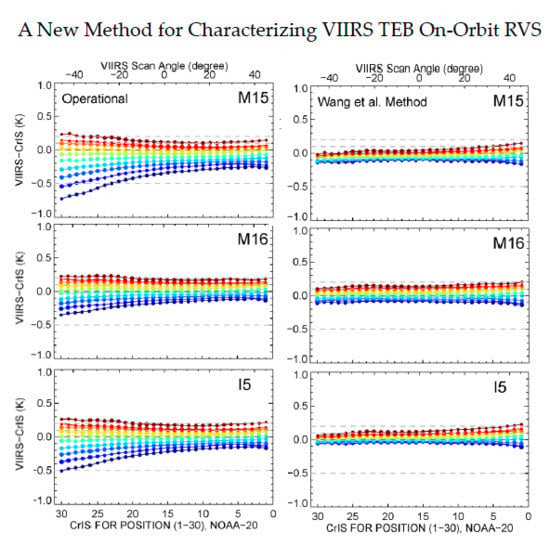A New Method for Characterizing NOAA-20/S-NPP VIIRS Thermal Emissive Bands Response Versus Scan Using On-Orbit Pitch Maneuver Data
Abstract
1. Introduction
2. VIIRS TEB On-Orbit Calibration Algorithm and Scan Angle/ Scene Temperature Dependent Biases
2.1. VIIRS TEB On-Orbit Calibration Algorithm
2.2. VIIRS Scan Angle and Angle of Incidence (AOI) on the HAM
2.3. VIIRS Prelaunch TEB RVS
- Inconsistent RVS values exist near AOImin (28.60°). In other words, different RVS values occur when the AOIs are the same.
- In a prelaunch RVS LUT, all values are modeled using 2nd order polynomials as functions of AOIs and normalized to SV [4]. However, in the NOAA-20 operational RVS LUT, 2nd order polynomial curves fitted using EV RVS converge ~2° earlier than SV AOI, consistent with the −2° AOI error in the prelaunch M15 RVS found in Moyer et al. [9].
- OBCBB RVS values do not match EV RVS at −8° scan angle.
2.4. VIIRS TEB Scan Angle and Scene Temperature Dependent Biases
3. Methods for Characterizing VIIRS TEB RVS Using On-Orbit Pitch Maneuver Data
3.1. Selection of On-orbit Pitch Maneuver Data for TEB RVS Characterization
- A complete view of the deep space, and away from Earth radiation contamination.
- S/MWIR and LWIR cold FPAs are stably controlled at nominal operating temperatures.
3.2. The Wu et al. Method
3.3. The Wang et al. Method
4. Comparisons of Prelaunch and On-Orbit RVS
4.1. Deriving On-Orbit RVS Using the Wang et al. Method
4.2. Deriving On-orbit RVS Using the Wu et al. Method
4.3. Comparison of Prelaunch RVS and the Wang et al. Method Derived On-Orbit RVS
4.4. Comparison of Prelaunch RVS and the Wu et al. Method Derived On-Orbit RVS
5. Impacts of On-Orbit RVS on TEB SDR Products
5.1. VIIRS–CrIS Inter-Comparison
5.2. Evaluation of the Wu et al. Method Derived On-Orbit RVS for NOAA-20
5.3. Evaluation of the Wang et al. Method Derived On-Orbit RVS for NOAA-20 and S-NPP
5.3.1. VIIRS–CrIS BT Differences for Reprocessed NOAA-20 TEB SDRs
5.3.2. VIIRS–CrIS BT Differences for Reprocessed S-NPP TEB SDRs
6. Summary
Author Contributions
Funding
Acknowledgments
Conflicts of Interest
References
- Cao, C.; Xiong, J.; Blonski, S.; Liu, Q.; Uprety, S.; Shao, X.; Bai, Y.; Weng, F. Suomi NPP VIIRS sensor data record verification, validation, and long-term performance monitoring. J. Geophys. Res. Atmos. 2013, 118, 11664–11678. [Google Scholar] [CrossRef]
- Cao, C.; De Luccia, F.J.; Xiong, X.; Wolfe, R.; Weng, F. Early on-orbit performance of the Visible Infrared Imaging Radiometer Suite onboard the Suomi National Polar-Orbiting Partnership (S-NPP) satellite. IEEE Trans. Geosci. Remote Sens. 2014, 52, 1142–1156. [Google Scholar] [CrossRef]
- VIIRS Radiometric Calibration ATBD. Joint Polar Satellite System (JPSS) VIIRS Radiometric Calibration Algorithm Theoretical Basis Document (ATBD). In NOAA/NESDIS/STAR: 2013; National Oceanic and Atmospheric Administration: College Park, MD, USA, 2013. [Google Scholar]
- Moyer, D.; McIntire, J.; Oudrari, H.; McCarthy, J.; Xiong, X.; De Luccia, F. JPSS-1 VIIRS Pre-Launch Response Versus Scan Angle Testing and Performance. Remote Sens. 2016, 8, 141. [Google Scholar] [CrossRef]
- Wu, A.; Xiong, X.; Chiang, K. Postlaunch assessment of the response versus scan angle for the thermal emissive bands of visible infrared imaging radiometer suite on-board the Suomi national polar-orbiting partnership satellite. J. Appl. Remote Sens. 2017, 11, 10. [Google Scholar] [CrossRef]
- NOAA STAR. NOAA VIIRS SDR Operational Processing Look-Up-Tables. Available online: ftp://ftp.star.nesdis.noaa.gov/pub/smcd/VIIRS_SDR/ (accessed on 19 June 2019).
- Cao, C.; Blonski, S.; Wang, W.; Uprety, S.; Shao, X.; Choi, J.; Lynch, E.; Kalluri, S. NOAA-20 VIIRS on-orbit performance, data quality, and operational Cal/Val support. In Proceedings of the SPIE Asia-Pacific Remote Sensing, Honolulu, HI, USA, 24–26 September 2018; Volume 107810K. [Google Scholar]
- Johnson, E.H.; Lovelace, A.; Montoya, J.H.; Yee, J.K. JPSS-1 VIIRS emissive band radiometric performance trending. In Proceedings of the SPIE Remote Sensing (SPIE), Berlin, Germany, 25 September 2018; Volume 10785. [Google Scholar]
- Moyer, D.; Moeller, C.; Luccia, F.D. NOAA-20 VIIRS thermal emissive band calibration error comparison with heritage VIIRS sensors. In Proceedings of the SPIE Remote Sensing (SPIE), Berlin, Germany, 25 September 2018; Volume 10785. [Google Scholar]
- Wu, A.; Xiong, X.; Chiang, K.; Sun, C. Assessment of the NPP VIIRS RVS for the thermal emissive bands using the first pitch maneuver observations. In Proceedings of the SPIE Optical Engineering+Applications (SPIE), San Diego, CA, USA, 15 October 2012; Volume 8510. [Google Scholar]
- Wu, A.; Xiong, X.; Chiang, V. Determination of the NOAA-20 VIIRS TEB RVS from emissive radiation measurements during the pitch maneuver. In Proceedings of the SPIE Asia-Pacific Remote Sensing, Honolulu, HI, USA, 23 October 2018; Volume 10781. [Google Scholar]
- Cao, C.; Wang, W.; Blonski, S.; Zhang, B. Radiometric traceability diagnosis and bias correction for the Suomi NPP VIIRS long-wave infrared channels during blackbody unsteady states. J. Geophys. Res. Atmos. 2017, 122, 5286–5297. [Google Scholar] [CrossRef]
- Datla, R.; Shao, X.; Cao, C.; Wu, X. Comparison of the Calibration Algorithms and SI Traceability of MODIS, VIIRS, GOES, and GOES-R ABI Sensors. Remote Sens. 2016, 8, 126. [Google Scholar] [CrossRef]
- Efremova, B.; McIntire, J.; Moyer, D.; Wu, A.; Xiong, X. S-NPP VIIRS thermal emissive bands on-orbit calibration and performance. J. Geophys. Res. Atmos. 2014, 119, 10,859–10,875. [Google Scholar] [CrossRef]
- McIntire, J.; Moyer, D.; Chang, T.; Oudrari, H.; Xiong, X. Pre-Launch JPSS-2 VIIRS Response versus Scan Angle Characterization. Remote Sens. 2017, 9, 1300. [Google Scholar] [CrossRef]
- Wang, L.; Chen, Y. Inter-Comparing SNPP and NOAA-20 CrIS Toward Measurement Consistency and Climate Data Records. IEEE J. Sel. Top. Appl. Earth Obs. Remote Sens. 2019, in press. [Google Scholar] [CrossRef]
- NOAA CLASS. The Comprehensive Large Array-Data Stewardship System (CLASS). Available online: https://www.avl.class.noaa.gov/ (accessed on 1 July 2019).
- Cao, C.; Xiong, X.J.; Wolfe, R.; DeLuccia, F.; Liu, Q.M.; Blonski, S.; Lin, G.G.; Nishihama, M.; Pogorzala, D.; Oudrari, H.; et al. Visible Infrared Imaging Radiometer Suite (VIIRS) Sensor Data Record (SDR) User’s Guide, Version 1.2; NOAA Technical Report NESDIS 142; NOAA: College Park, MD, USA, 2013.
- McIntire, J.; Moyer, D.; Oudrari, H.; Xiong, X. Pre-Launch Radiometric Characterization of JPSS-1 VIIRS Thermal Emissive Bands. Remote Sens. 2016, 8, 47. [Google Scholar] [CrossRef]
- VIIRS SDR OAD. Joint Polar Satellite System (JPSS) Operational Algorithm Description (OAD) Document for VIIRS Geolocation (GEO) Sensor Data Record (SDR) and Calibration (CAL) SDR Software; NOAA/NESDIS/STAR: 2015; NOAA: College Park, MD, USA, 2015.
- Wang, W.; Cao, C.; Ignatov, A.; Liang, X.; Li, Z.; Wang, L.; Zhang, B.; Blonski, S.; Li, J. Improving the Calibration of Suomi NPP VIIRS Thermal Emissive Bands during Blackbody Warm-Up/Cool-Down. IEEE Trans. Geosci. Remote Sens. 2019, 57, 1977–1994. [Google Scholar] [CrossRef]
- Wang, L.; Wu, X.; Weng, F.; Goldberg, M.D. Effects of Ice Decontamination on GOES-12 Imager Calibration. IEEE Trans. Geosci. Remote Sens. 2013, 51, 1224–1230. [Google Scholar] [CrossRef]
- Tobin, D.; Revercomb, H.; Knuteson, B.; Best, F.; Taylor, J.; Deslover, D.; Borg, L.; Moeller, C.; Martin, G.; Kuehn, R.; et al. Suomi NPP/JPSS Cross-Track Infrared Sounder (CrIS): Intercalibration with AIRS, IASI, and VIIRS. In Proceedings of the 93rd AMS Annual Conference, Austin, TX, USA, 6–10 January 2013. [Google Scholar]
- Wang, L.; Tremblay, D.; Zhang, B.; Han, Y. Fast and Accurate Collocation of the Visible Infrared Imaging Radiometer Suite Measurements with Cross-Track Infrared Sounder. Remote Sens. 2016, 8, 76. [Google Scholar] [CrossRef]
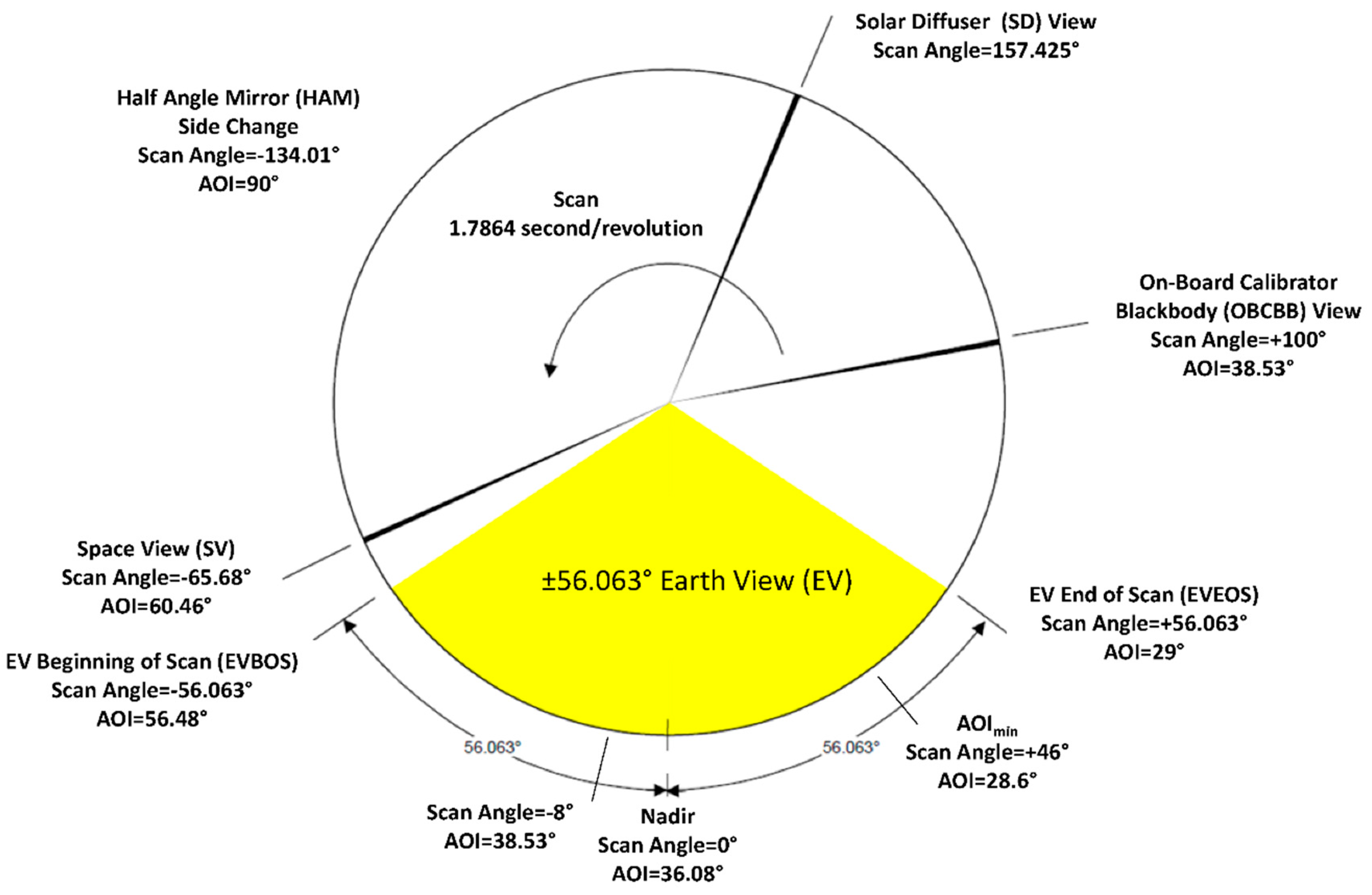
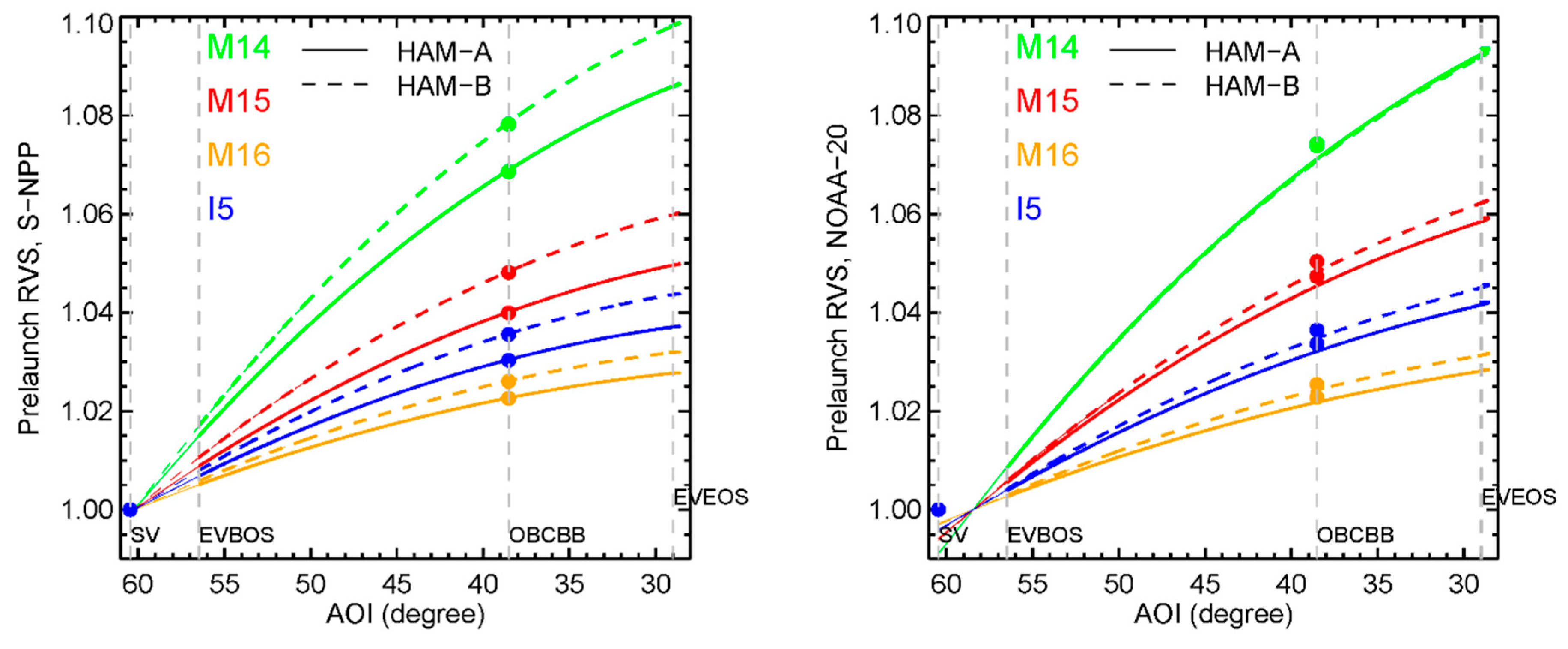
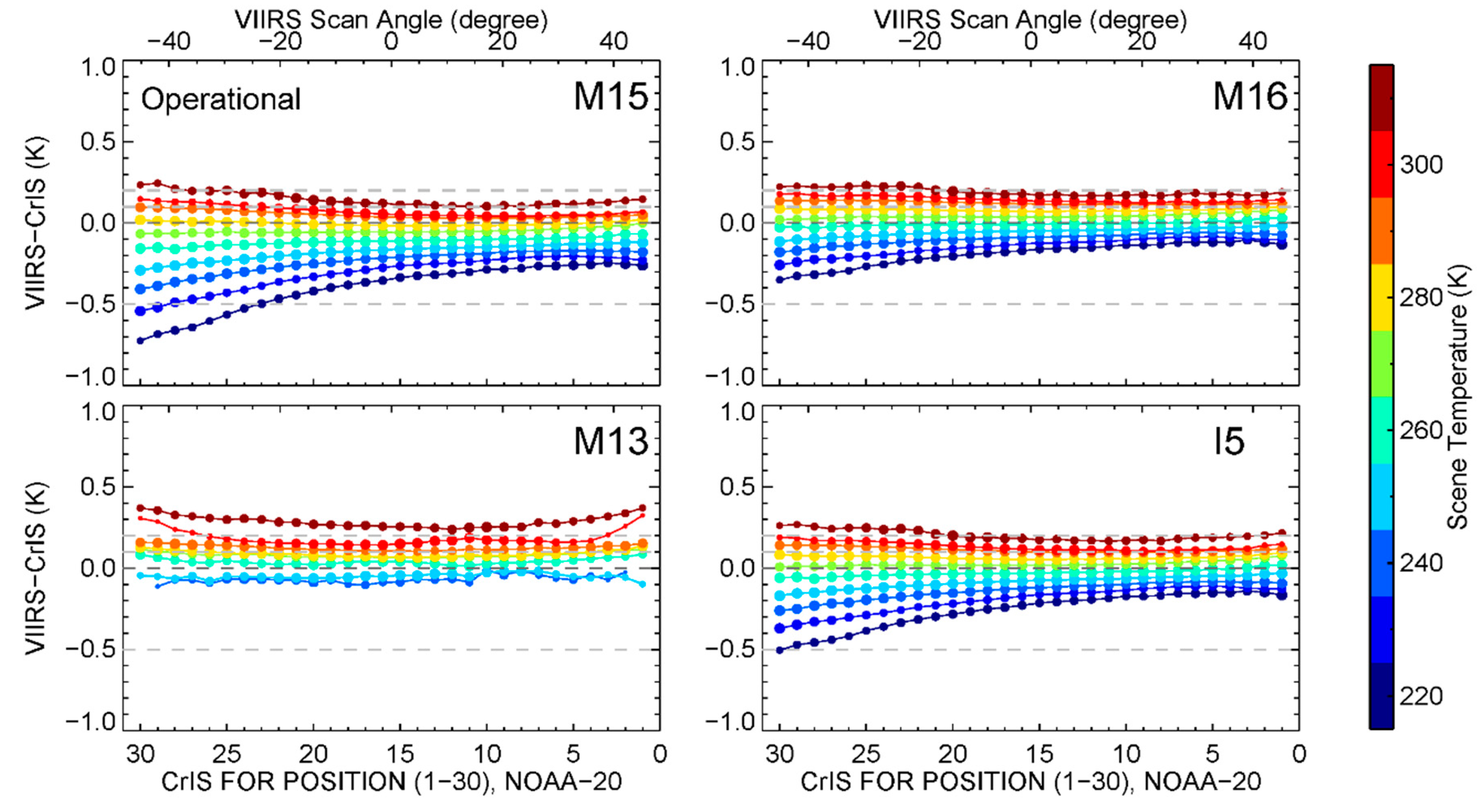
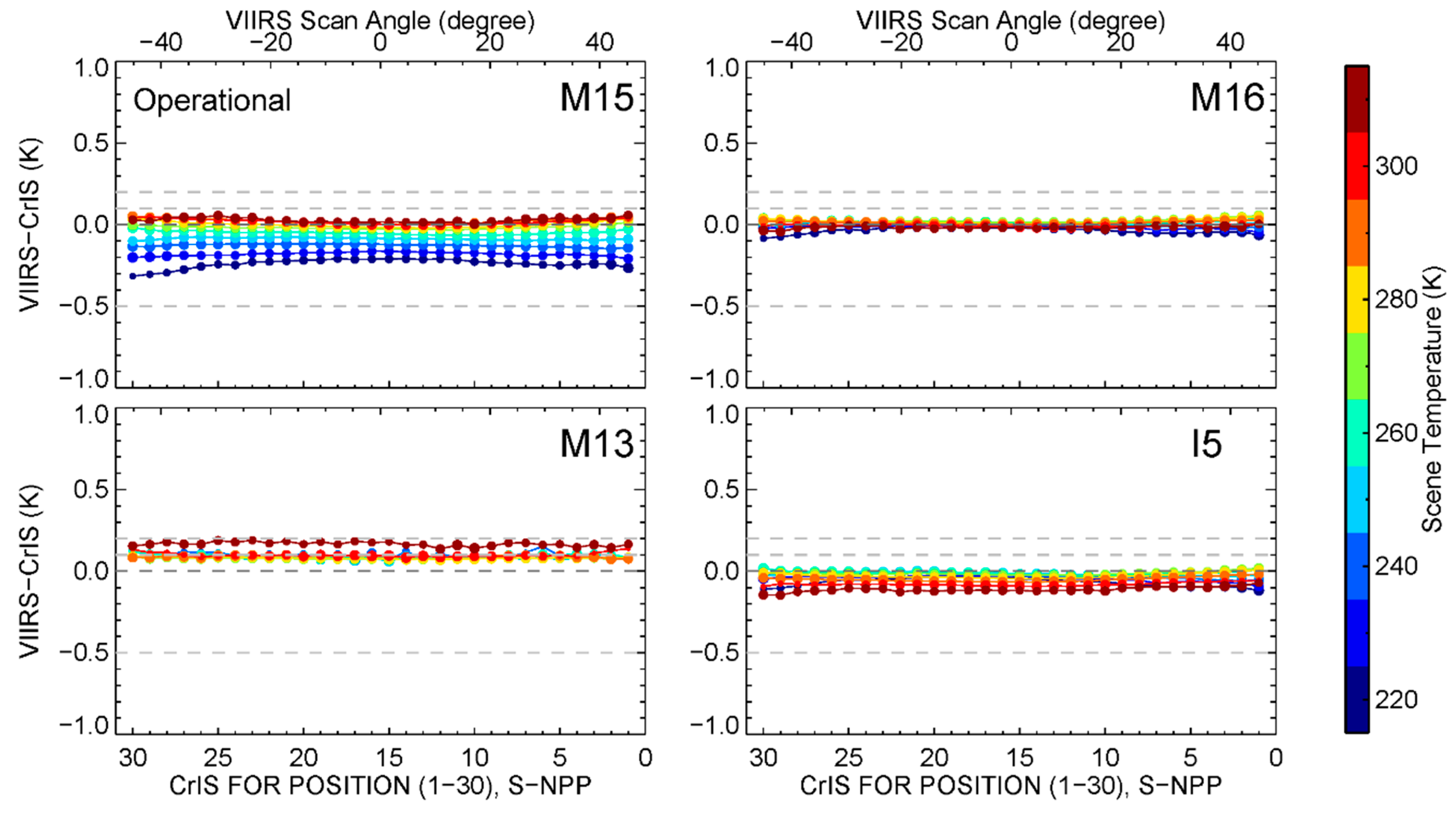
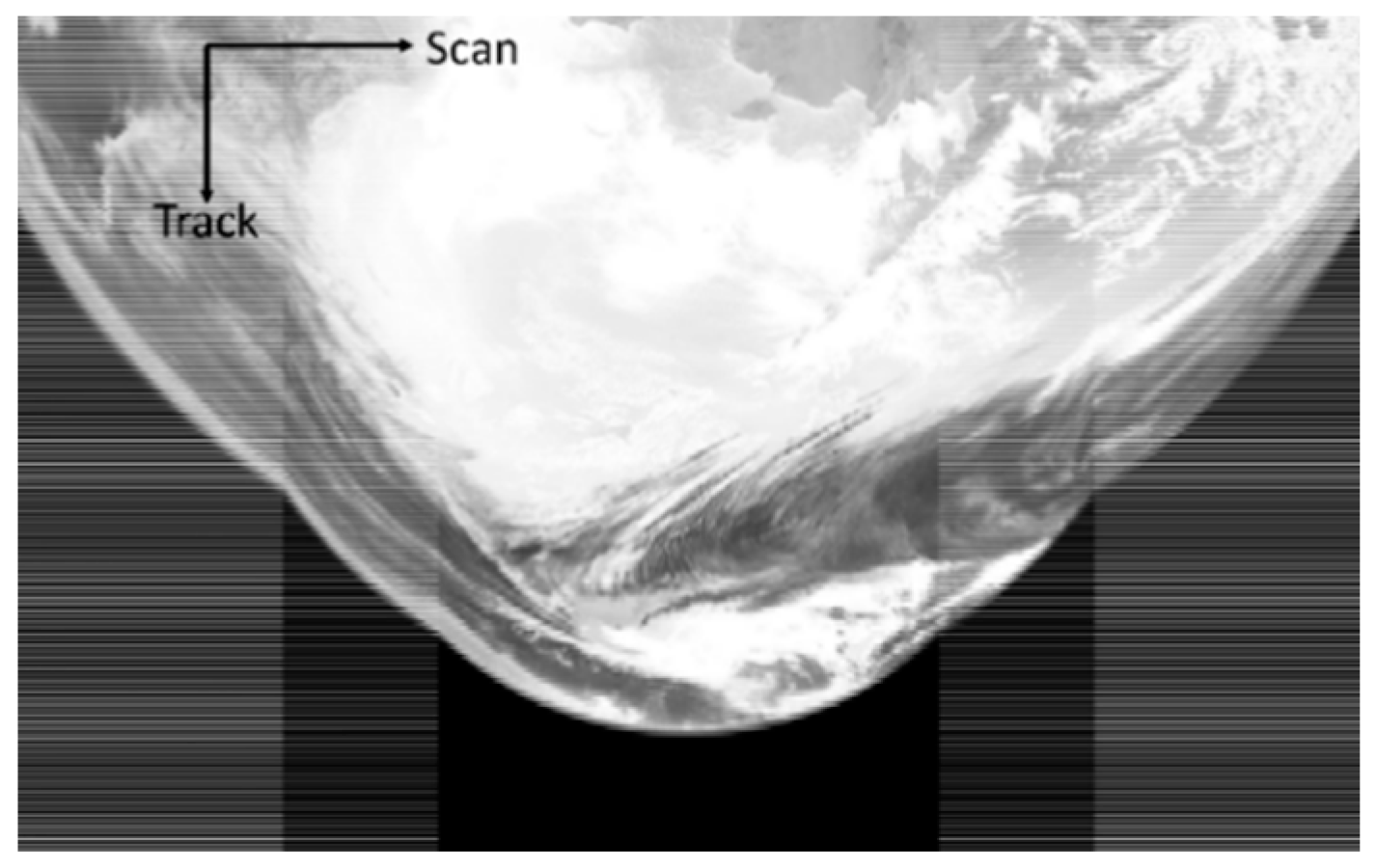
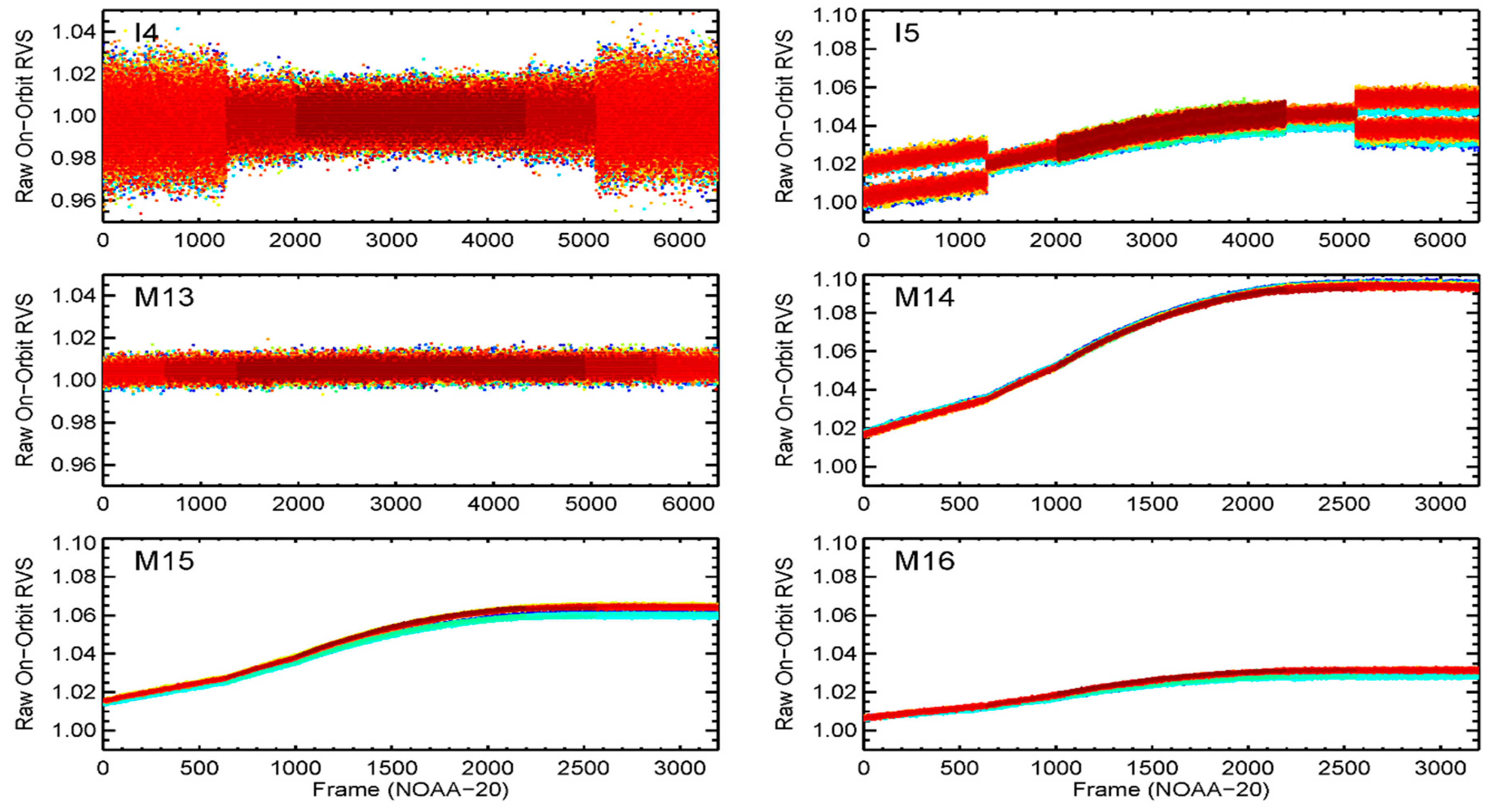
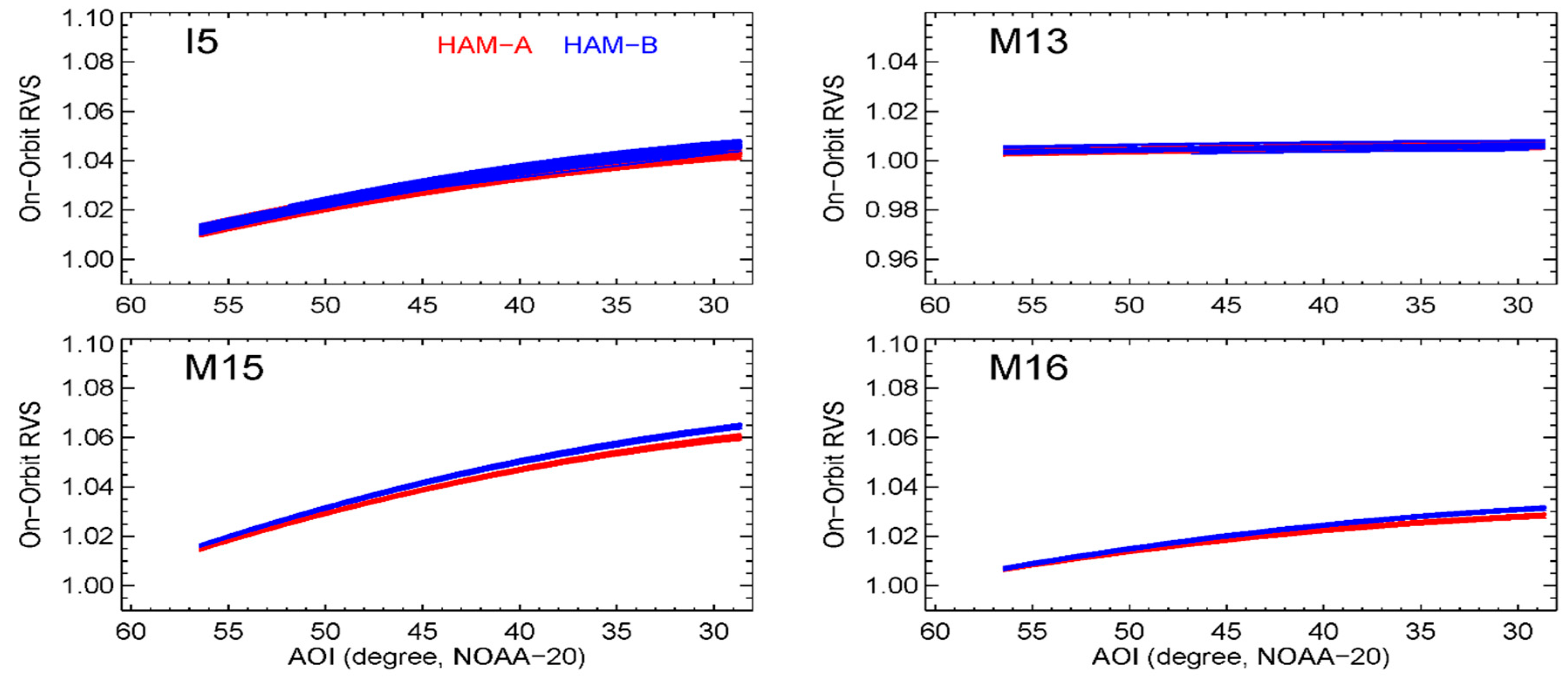
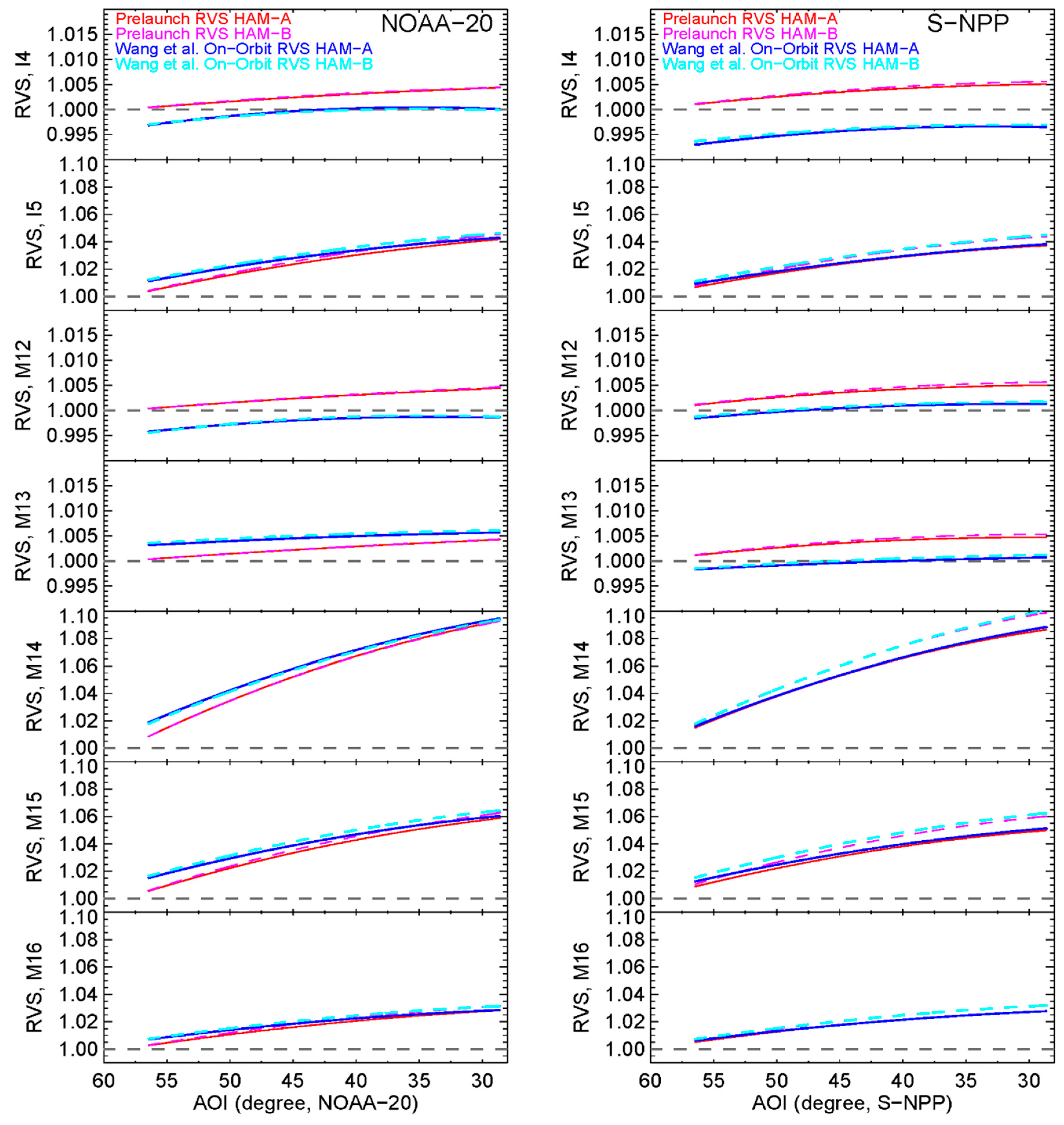
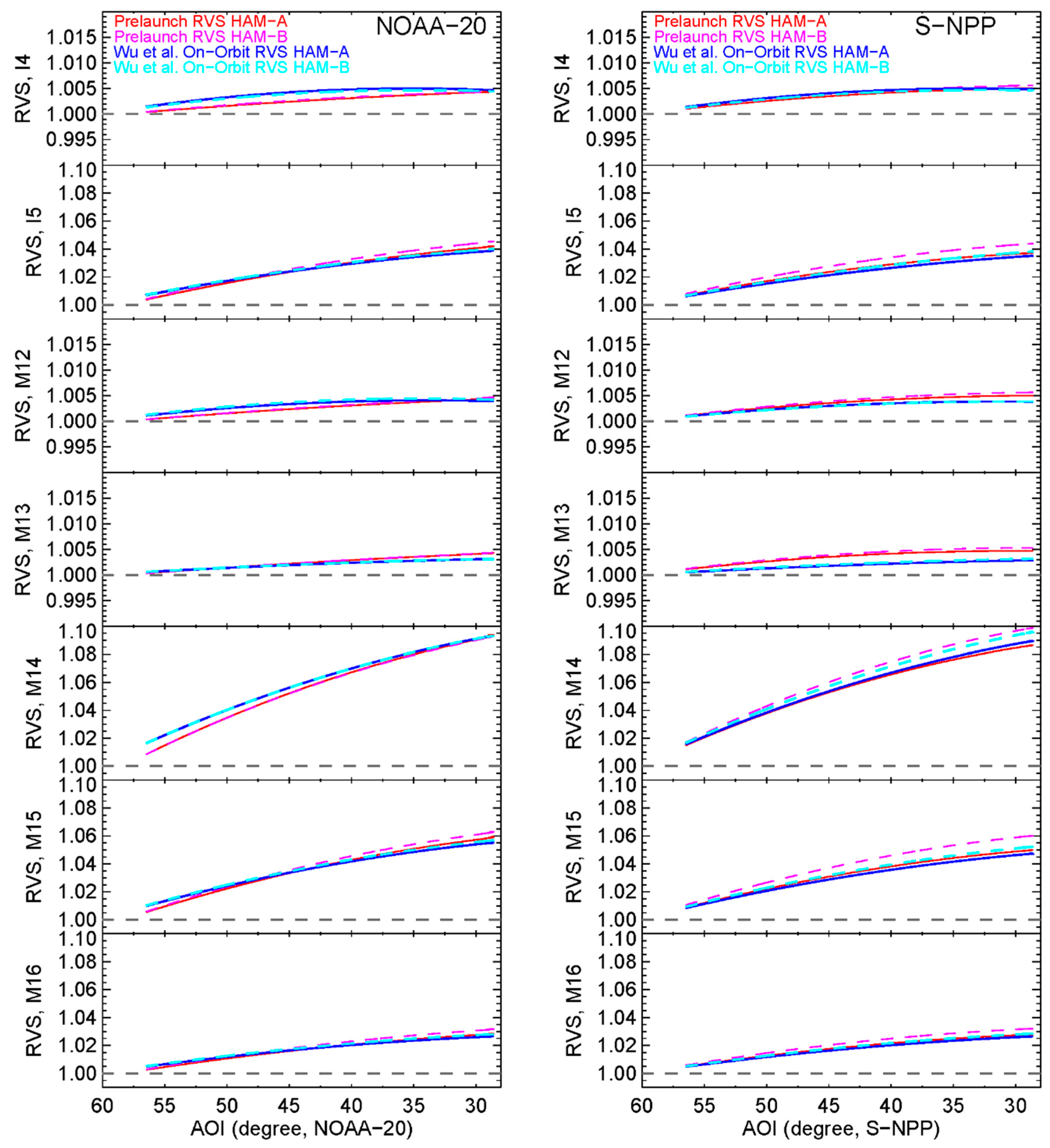

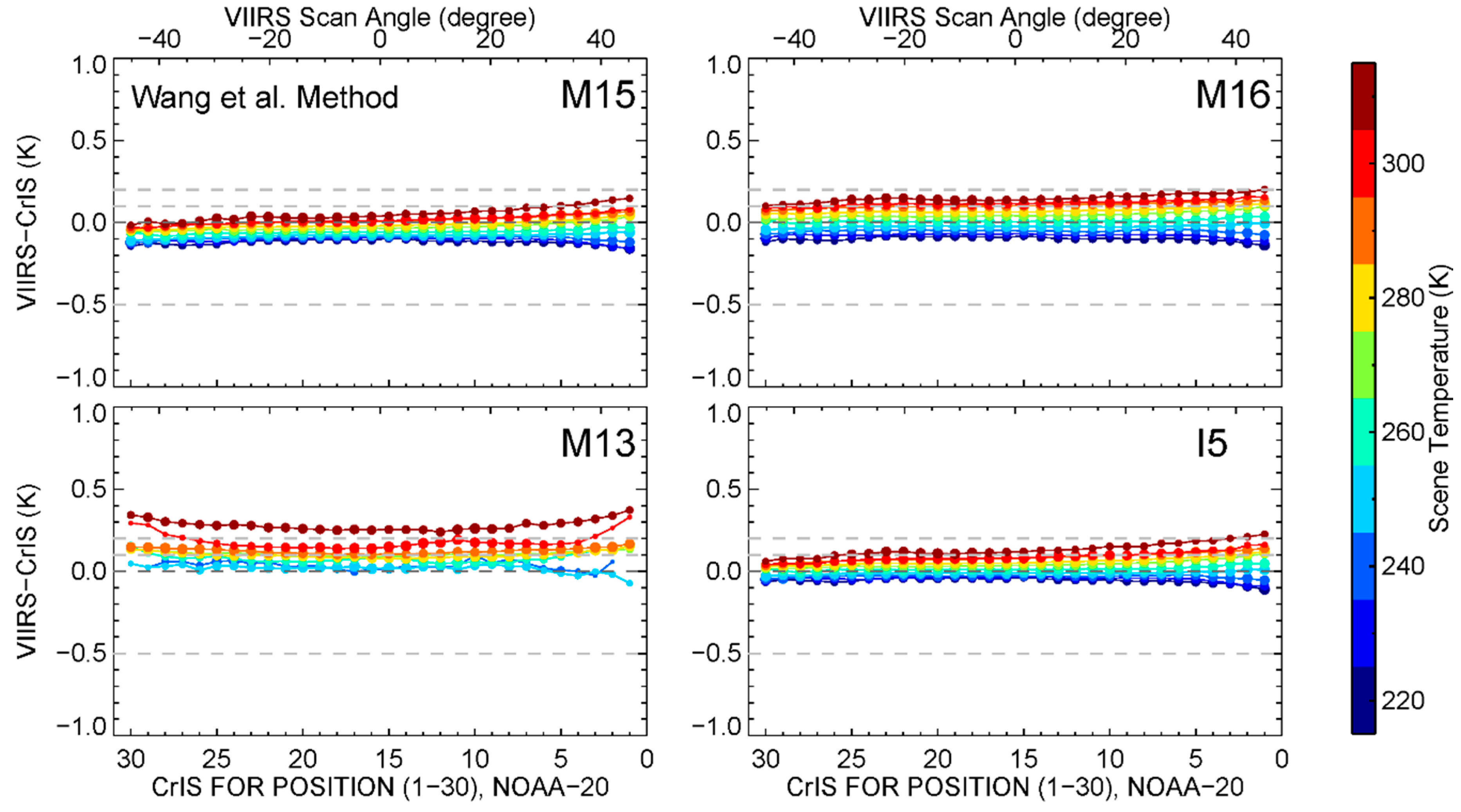
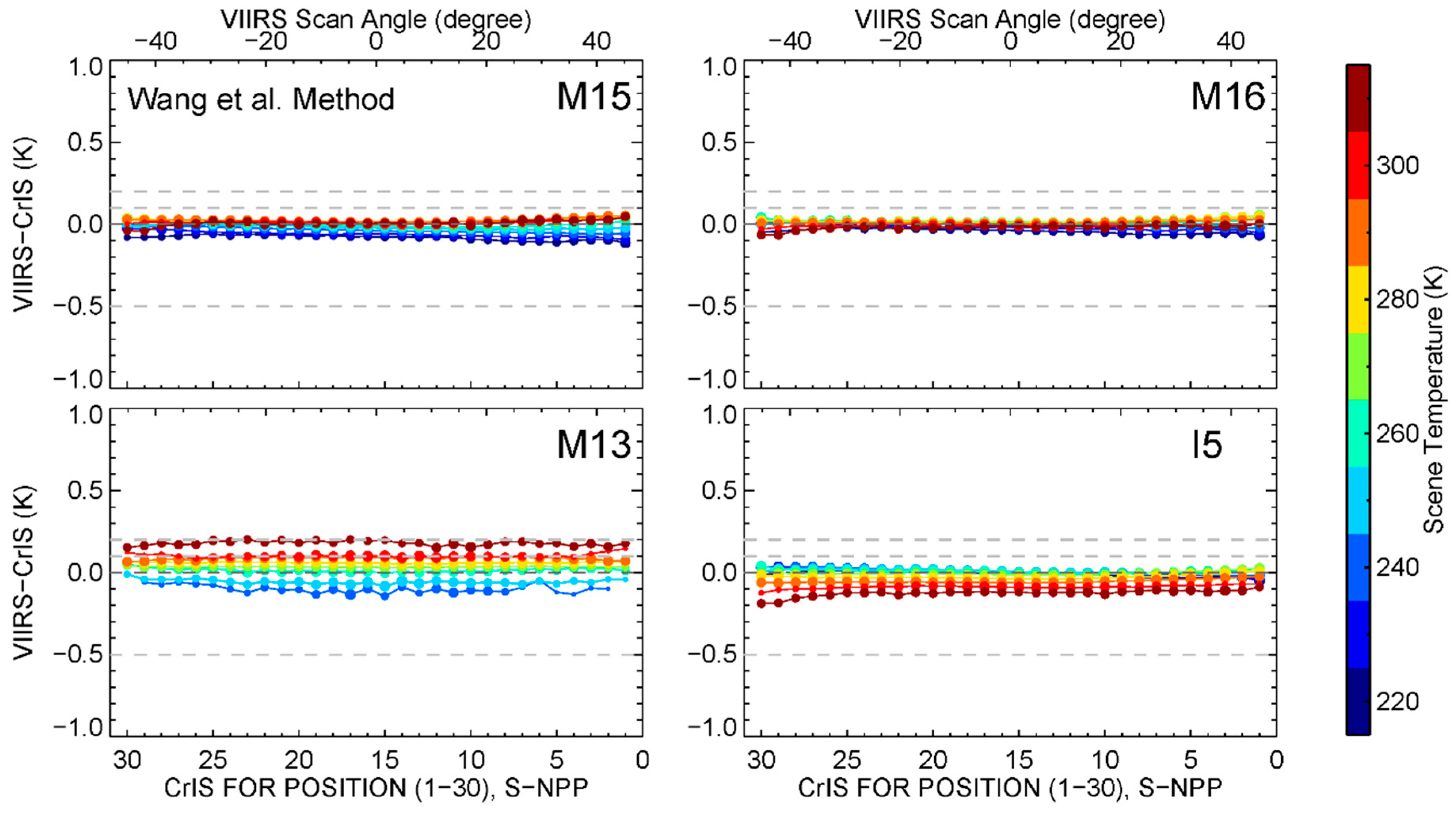

| VIIRS TEBs | Spatial Resolution (m) | Center Wavelength (µm) | Gain | Ttyp (K) | NEdT Spec (K) | NEdT On-Orbit (K) | |||
|---|---|---|---|---|---|---|---|---|---|
| NOAA-20 | S-NPP | NOAA-20 | S-NPP | ||||||
| MWIR | M12 | 750 | 3.700 | 3.697 | S | 270 | 0.396 | 0.12 | 0.12 |
| I4 | 375 | 3.753 | 3.753 | S | 270 | 2.5 | 0.42 | 0.40 | |
| M13 | 750 | 4.070 | 4.067 | H | 300 | 0.107 | 0.04 | 0.04 | |
| L | 380 | 0.423 | |||||||
| - | - | ||||||||
| LWIR | M14 | 750 | 8.583 | 8.578 | S | 270 | 0.091 | 0.05 | 0.06 |
| M15 | 750 | 10.703 | 10.729 | S | 300 | 0.07 | 0.02 | 0.03 | |
| I5 | 375 | 11.450 | 11.469 | S | 210 | 1.5 | 0.42 | 0.40 | |
| M16 | 750 | 11.869 | 11.845 | S | 300 | 0.072 | 0.03 | 0.03 | |
| NOAA-20 | S-NPP | |
|---|---|---|
| Granule Used | January 31, 2018 | February 20, 2012 |
| 13:46:40–13:48:04 UTC | 18:26:29–18:27:44 UTC | |
| Start Scan Number | 11 | 1 |
| Number of scans used | 10 (5 scans for each HAM-side) | 10 (5 scans for each HAM-side) |
| S/MWIR FPA Temp. | 80.29K | 79.86K |
| LWIR FPA Temp. | 80.48K | 79.95K |
| Unit: % | On-Orbit RVS (the Wang et al. Method)—Prelaunch RVS | |||||
|---|---|---|---|---|---|---|
| −56.063° | −8° | +41° | +56.063° | Scan Avg. | ||
| NOAA-20 | I4 | −0.35/−0.34 | −0.30/−0.34 | −0.43/−0.45 | −0.43/−0.45 | −0.35/−0.38 |
| I5 | 0.73/0.80 | 0.30/0.29 | 0.10/0.08 | 0.07/0.04 | 0.32/0.32 | |
| M12 | −0.46/−0.48 | −0.47/−0.45 | −0.58/−0.59 | −0.59/−0.59 | −0.51/−0.51 | |
| M13 | 0.28/0.32 | 0.20/0.24 | 0.14/0.17 | 0.14/0.17 | 0.19/0.23 | |
| M14 | 1.01/0.93 | 0.37/0.33 | 0.12/0.08 | 0.04/0.01 | 0.41/0.36 | |
| M15 | 0.95/1.05 | 0.35/0.40 | 0.13/0.16 | 0.09/0.11 | 0.40/0.45 | |
| M16 | 0.44/0.45 | 0.16/0.13 | 0.02/-0.01 | 0.00/-0.03 | 0.17/0.15 | |
| S-NPP | I4 | −0.80/−0.75 | −0.79/−0.80 | −0.85/−0.86 | −0.85/−0.86 | −0.81/−0.81 |
| I5 | 0.25/0.31 | 0.04/0.05 | 0.09/0.10 | 0.09/0.10 | 0.11/0.13 | |
| M12 | −0.26/−0.24 | −0.33/−0.35 | −0.37/−0.39 | −0.37/−0.39 | −0.33/−0.34 | |
| M13 | −0.28/−0.27 | −0.42/−0.41 | −0.39/−0.40 | −0.40/−0.41 | −0.39/−0.39 | |
| M14 | 0.09/0.07 | 0.06/0.03 | 0.18/0.17 | 0.18/0.17 | 0.11/0.09 | |
| M15 | 0.37/0.47 | 0.15/0.22 | 0.15/0.22 | 0.15/0.22 | 0.19/0.27 | |
| M16 | 0.11/0.14 | −0.02/−0.02 | −0.01/−0.01 | −0.01/−0.01 | 0.01/0.02 | |
| Unit: % | On-Orbit RVS (the Wu et al. Method)—Prelaunch RVS | ||||
|---|---|---|---|---|---|
| −56.063° | −8° | +56.063° | Scan Avg. | ||
| NOAA-20 | I4 | 0.11/0.09 | 0.16/0.11 | 0.03/0.00 | 0.10/0.07 |
| I5 | 0.32/0.30 | −0.10/−0.27 | −0.34/−0.55 | −0.09/−0.23 | |
| M12 | 0.08/0.09 | 0.07/0.09 | −0.05/−0.04 | 0.03/0.04 | |
| M13 | 0.02/0.02 | −0.06/−0.06 | −0.12/−0.12 | −0.06/−0.06 | |
| M14 | 0.78/0.79 | 0.22/0.25 | −0.09/−0.04 | 0.25/0.28 | |
| M15 | 0.44/0.43 | −0.14/−0.29 | −0.40/−0.60 | −0.09/−0.23 | |
| M16 | 0.22/0.22 | −0.04/−0.17 | −0.20/−0.37 | −0.04/−0.15 | |
| S-NPP | I4 | 0.03/0.01 | 0.04/−0.03 | −0.02/−0.09 | 0.02/−0.04 |
| I5 | −0.06/−0.12 | −0.25/−0.54 | −0.20/−0.55 | −0.19/−0.45 | |
| M12 | −0.01/−0.02 | −0.08/−0.13 | −0.12/−0.18 | −0.08/−0.12 | |
| M13 | −0.06/−0.06 | −0.20/−0.22 | −0.18/−0.22 | −0.17/−0.20 | |
| M14 | 0.06/−0.04 | 0.13/−0.32 | 0.28/−0.27 | 0.17/−0.24 | |
| M15 | −0.04/−0.13 | −0.24/−0.65 | −0.24/−0.74 | −0.20/−0.57 | |
| M16 | −0.02/−0.07 | −0.14/−0.33 | −0.13/−0.35 | −0.11/−0.28 | |
| Scene Temperature | Prelaunch RVS | Wang et al. On-Orbit RVS | ||||||
|---|---|---|---|---|---|---|---|---|
| M15 | M16 | M13 | I5 | M15 | M16 | M13 | I5 | |
| 220 | 0.40 | 0.19 | - | 0.26 | 0.12 | 0.10 | - | 0.06 |
| 230 | 0.31 | 0.14 | - | 0.20 | 0.11 | 0.08 | - | 0.05 |
| 240 | 0.24 | 0.10 | - | 0.14 | 0.10 | 0.05 | - | 0.03 |
| 250 | 0.18 | 0.05 | 0.05 | 0.09 | 0.08 | 0.02 | 0.03 | 0.01 |
| 260 | 0.11 | 0.01 | 0.04 | 0.03 | 0.06 | 0.01 | 0.08 | 0.02 |
| 270 | 0.05 | 0.04 | 0.08 | 0.03 | 0.03 | 0.05 | 0.11 | 0.04 |
| 280 | 0.01 | 0.08 | 0.09 | 0.07 | 0.02 | 0.07 | 0.10 | 0.06 |
| 290 | 0.05 | 0.12 | 0.13 | 0.11 | 0.02 | 0.11 | 0.12 | 0.08 |
| 300 | 0.07 | 0.15 | 0.19 | 0.13 | 0.02 | 0.12 | 0.18 | 0.09 |
| 310 | 0.15 | 0.19 | 0.29 | 0.20 | 0.05 | 0.15 | 0.28 | 0.13 |
| Scene Temperature | Prelaunch RVS | Wang et al. On-Orbit RVS | ||||||
|---|---|---|---|---|---|---|---|---|
| M15 | M16 | M13 | I5 | M15 | M16 | M13 | I5 | |
| 220 | 0.24 | 0.04 | - | 0.07 | 0.08 | 0.04 | - | 0.01 |
| 230 | 0.18 | 0.02 | - | 0.05 | 0.06 | 0.02 | - | 0.01 |
| 240 | 0.13 | 0.01 | - | 0.03 | 0.03 | 0.01 | - | 0.01 |
| 250 | 0.09 | 0.01 | 0.08 | 0.02 | 0.02 | 0.01 | 0.06 | 0.01 |
| 260 | 0.05 | 0.02 | 0.09 | 0.01 | 0.01 | 0.01 | 0.01 | 0.01 |
| 270 | 0.02 | 0.02 | 0.08 | 0.02 | 0.01 | 0.02 | 0.03 | 0.01 |
| 280 | 0.01 | 0.02 | 0.08 | 0.03 | 0.02 | 0.02 | 0.06 | 0.03 |
| 290 | 0.02 | 0.01 | 0.09 | 0.05 | 0.02 | 0.01 | 0.09 | 0.05 |
| 300 | 0.02 | 0.01 | 0.10 | 0.08 | 0.01 | 0.01 | 0.10 | 0.09 |
| 310 | 0.03 | 0.02 | 0.17 | 0.11 | 0.01 | 0.02 | 0.18 | 0.13 |
© 2019 by the authors. Licensee MDPI, Basel, Switzerland. This article is an open access article distributed under the terms and conditions of the Creative Commons Attribution (CC BY) license (http://creativecommons.org/licenses/by/4.0/).
Share and Cite
Wang, W.; Cao, C.; Blonski, S. A New Method for Characterizing NOAA-20/S-NPP VIIRS Thermal Emissive Bands Response Versus Scan Using On-Orbit Pitch Maneuver Data. Remote Sens. 2019, 11, 1624. https://doi.org/10.3390/rs11131624
Wang W, Cao C, Blonski S. A New Method for Characterizing NOAA-20/S-NPP VIIRS Thermal Emissive Bands Response Versus Scan Using On-Orbit Pitch Maneuver Data. Remote Sensing. 2019; 11(13):1624. https://doi.org/10.3390/rs11131624
Chicago/Turabian StyleWang, Wenhui, Changyong Cao, and Slawomir Blonski. 2019. "A New Method for Characterizing NOAA-20/S-NPP VIIRS Thermal Emissive Bands Response Versus Scan Using On-Orbit Pitch Maneuver Data" Remote Sensing 11, no. 13: 1624. https://doi.org/10.3390/rs11131624
APA StyleWang, W., Cao, C., & Blonski, S. (2019). A New Method for Characterizing NOAA-20/S-NPP VIIRS Thermal Emissive Bands Response Versus Scan Using On-Orbit Pitch Maneuver Data. Remote Sensing, 11(13), 1624. https://doi.org/10.3390/rs11131624





